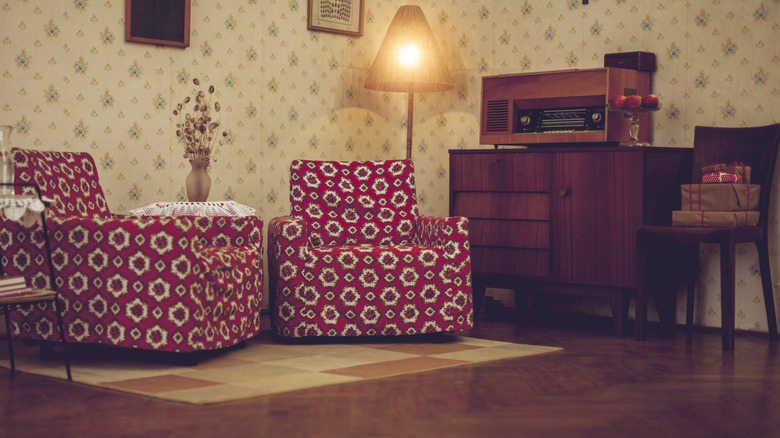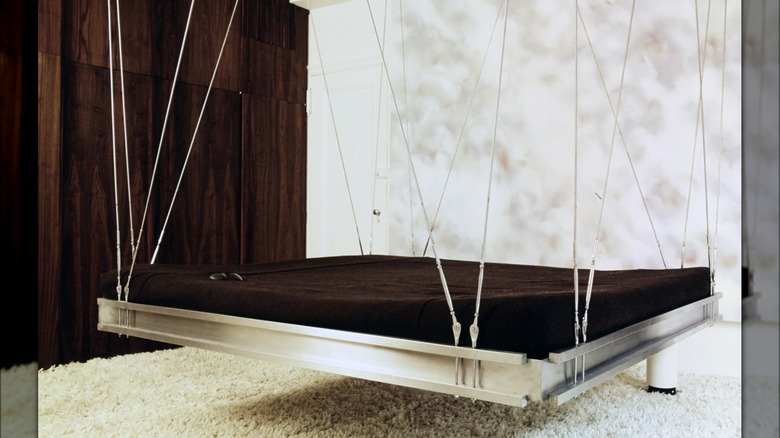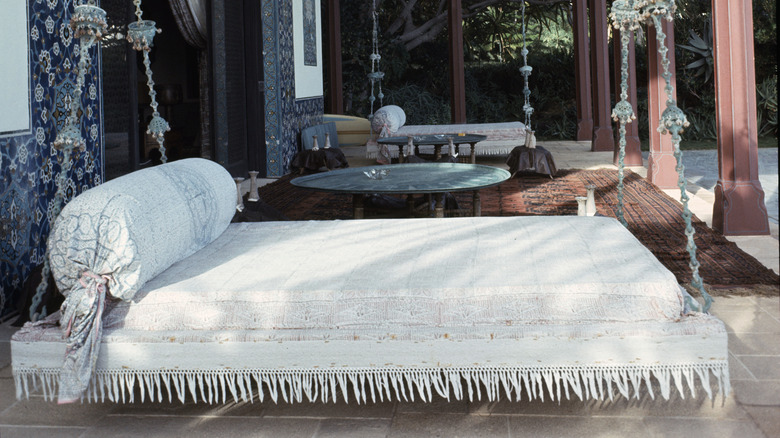This Forgotten Murphy Bed Competitor Hid The Bed In An Odd Spot
If you want your spare room to do double duty, a Murphy bed is the perfect way to maximize a guest space. Yet even the innovative tuck-away nature of this efficient sleeping spot didn't mean it was alone in the market. Did you know there was a competing bed with a similar purpose? Except, in the case of the Sorlien Ceiling Bed, it hid away in the rafters instead of a wall unit.
Curious about this contraption, House Digest got in touch with Dr. Lori Verderame, aka Dr. Lori, a Ph.D. antiques appraiser. Speaking exclusively with House Digest, Verderame explained how these innovative beds worked their magic. The iron beds with "sag-less springs" were moved up and down with a hand crank, according to the expert appraiser. "The ceiling beds were encased in a box structure that was housed in the ceiling and accessed as needed," she noted. "The floor space below would only be taken up when the bed was in use. The box protected the mattress and bedding from dust, pests, etc." All that freed-up floor room sounds ideal, especially if you're struggling to find the perfect Murphy bed for a space.
Sorlien beds were able to lower and rise in 15 to 20 seconds, Verderame added, also mentioning that the Sorlien Ceiling Bed Company advertised that two of their carpenters were capable of installing up to ten beds per day in under-construction homes. That was opposed to already built houses, where they could only install two in a day since they needed a cut ceiling opening to fit into.
Sorlien beds were a solution to small spaces
According to Dr. Lori Verderame, the Murphy bed and the Sorlien Ceiling Bed are not that far apart in age. The Murphy was patented in 1908 and the Sorlien in 1913, Verderame said in an exclusive interview with House Digest. They were important innovations since metropolitan and suburban life was booming in the early 1900s which meant one thing — overcrowding.
"...overcrowding was a problem in major cities and small towns alike," Verderame explained. "Space for family members during the immigrant era was at a premium and the Sorlien company had already enjoyed success with its Murphy bed which was hidden in a wall space and pulled down to the floor for use." According to a Sorlien ad in a Sweets Architectural Catalog, circa 1917 (via Sears Modern Homes), the ceiling beds were perfect for any kind of dwelling or even porches. Plus, bedding wasn't disturbed when the Sorlien beds were raised or lowered, Verderame tells us.
Verderame notes that these ceiling beds are en vogue again and seem very inspired by their Sorlien counterparts. The big difference, in her view, is that the new beds are more comfortable and weigh less than the original design from 1913. Even Murphy beds got a facelift in the modern era, being lighter and easier to operate than their early counterparts.
When ceiling beds went out of style
If you haven't heard of Sorlien beds, it wouldn't be that shocking. They eventually gave way entirely to their still-famous Murphy bed companions. Dr. Lori Verderame, in an exclusive interview with House Digest, explained that they lost the popularity contest by the mid-1900s.
"By the post-war period, ceilings and attic spaces were prime real estate in new homes for American GIs returning from World War II," Verderame said. "Murphy beds turned dens into guest rooms while ceiling beds imposed on prime living room space when in use." Not taking up wall or closet space was no longer of much interest marketing-wise for consumers, the appraiser added.
On top of that, homeowners didn't want to plan around where their furniture lived in a room if a bed had to come down over it, explained Verderame. It seems what was once a bonus for space-saving needs became a burden. For the average homemaker, wall beds are easier to install, many are renter-friendly, and there are also more ways to customize Murphy beds.


